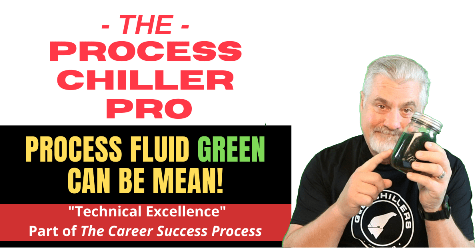Video of this Episode
On the Road?
Listen to AUDIO ONLY
version of the Podcast
Follow the Process Chiller Pro podcast on these platforms.
Listening on your phone or mobile device? These great podcast platforms may require apps to be installed to access the podcast on your mobile devices.
Get an email alert when new episodes are posted.
Show notes
This episode is the second installment of a two-part series covering process fluid issues that can lead to costly downtime.
I covered how rust can form in a process chillers fluid loop in the last episode. If you have not checked that out, I will provide a link to that episode in this episode’s show notes.
In this episode, I will look at the formation of algae.
When it comes to process chillers, your system fluid should always be clear, or if you are using colored glycol, whatever that color is.
If you see any unexpected coloration, your system fluid is not healthy, eventually heading for a shutdown.
My goal for this series on process fluid is to help my chiller pro’s out there quickly identify what is going so you can help your customer stave off costly shutdowns and potential equipment damage.
CLICK THIS LINK TO ACCESS THIS EPISODE IN BOTH AUDIO-ONLY AND VIDEO FORMATS.
The topic covered in this episode of the PCP podcast is a foundational component of my skilled trade’s success process that you see here.
We have a sign-up for a free five-day Mini-Course (coming soon) where I will share the four key elements of a success process that makes it possible (and I would argue likely) for you to become a millionaire working in skilled trades.
TO ACCESS THE PCA RESOURCE PAGE AND GET MORE INFORMATION ON THE SKILLED TRADES CAREER SUCCESS PYRAMID
Episode That Support This Topic.
New Episode – Process Fluid BROWN will SHUT YOU DOWN! – Process Chiller Pro Podcast – Process Chiller Academy => CLICK HERE to check out this episode.
Episode Transcript
Martin King 0:08
Hey guys, Martin King your process chiller Pro. This week we’re going to be covering algae in a process chiller loop. If you recall, last week we covered rust, we figured out what causes it what to do about it. And this week, we’re gonna do the same thing for algae. Now in general on a process chiller loop, when you do an inspection, you should see clear fluid. Now, the only exception to that would be if you’re running glycol, because some glycol manufacturers will put a dye in their glycol, and that’s totally normal, what you’re looking for is anomalies. And the thing about the discoloration of process fluid is it tends to have a very long fuse. Meaning is it’s there. But if it’s not detected and noticed and addressed, eventually it will turn into an expensive process, chiller failure, as well as potential damage to the chiller and whatever the process chillers cooling, so it’s super important. My goal, whether you’re a technician, or an end user, who’s in charge of doing maintenance on your own equipment, is to make it possible for you to identify what’s normal and what’s not. And make sure that you know enough about it to take action before it turns into a real problem for your system. So before we jump into this episode, a couple reminders, we produce all of our content in two different formats. We do video as well as audio only. So if you happen to be driving around in your service truck, listening to this content, that’s awesome. That means that you’re probably ahead of 90% of the technicians out there, mainly because you have the mindset of investment in yourself. So I commend you for that. However, if you are a little confused about the stuff I’m talking about, why don’t you just make a mental note, save the link if you’ve been notified through one of our social channels or email and pop over to the process Tiller academy.com page for this episode, and check it out in video format as well. It really helped fill in the gaps. Now I will do my very best as I’m going through this content to try to explain what I’m putting up on the screen. However, sometimes I just can’t do that good of a job at it because it tends to be a little bit technical. So make some time to do that. Lastly, if you’re into the HVAC, trade or skilled trades, and you’re learning about new stuff that I’m providing on these videos, I want to remind you that this content is really designed for people who are skilled trades people you’re in other words, you’re comfortable with refrigeration, you’re comfortable with electrical, and you have a good amount of common sense not to get yourself into situations where you can get yourself hurt. So my suggestion is, if you’re carrying out one of the things that I’ve described in any one of these videos, and you’re feeling a little bit uncomfortable, stop and find somebody with a little bit more experience to help you do these tasks that I’m talking about. So that’s my keep it safe guys suggestion. Well, without further ado, let’s jump into this new episode of the process chiller pro podcast.
Guys, as I touched on this algae that you find in the system is a problem and it can impact the operation of your chiller lead to downtime and potentially damage to your equipment. So I’m going to be covering in this episode what to do about this particular nemesis. My goal is to make sure that technicians and owners out there have processed solar equipment can quickly identify algae and figure out what to do about it to stave off disaster with respect to downtime. As they also touched on in the intro for this episode, we covered rust, which is another problem in a prior episode. So in the show notes for this episode, I’m going to provide a direct link to jump over to that. So watching both that episode as well as this one should keep you well covered, to understand what to do if you see potential problems with your process fluid. Also, as I mentioned in the last episode, I’m not a scientist, especially when it comes to algae. Algae is a bio growth, which is a very, very large subject. So if you’re a listener out there and you have things to add, please get in touch with me on LinkedIn, I’d be happy to take in your information and figure out a way to verify that information and get it out to our subscribers because the whole idea of this podcast is to make sure we all get a little bit smarter every day, I want to take a revisit to the three different types of process fluid that go into a process chiller application. So the most common by far is tap water, just regular old city water that you get. And as I mentioned in the last episode, it’s convenient, it’s cheap, it’s pressurized, so you don’t have to pump it in so it’s it’s usually the go to the second one is going to be distilled water which is my personal favorite if you happen to have a mission critical application, and you don’t want to deal with the minerals, which can cause rust, which I addressed last week, that’s a good solution to go to. The third one is deionized. Water, which I’m not a favorite of, there are a lot of people out there that have a strong argument for DI water, I do not recommend it. But that’s probably the third and most common type of fluid used and process. Let’s talk about what causes algae in a process chiller loop, I’m going to address this in two ways, I’m going to dress it in an open loop environment open chiller loop, and I’m going to talk about it in a closed chiller loop, because it’s important. And just as a side note, I’ll be coming out with an episode soon, that’s going to be actually covering the differences and advantages and disadvantages of both. So stay tuned for that. So let’s first talk about the components of algae, you need three things, in order for algae to form in a process to remove, you need to have what I call a catalyst. And a catalyst is usually some type of bacteria. That is is there, right? And that could be just about anything, you need to have oxygen or air, and you need to have light, those three components are absolutely essential to be able to grow algae in a process chiller loop. Now let’s talk about an open loop chiller for a second. So an open loop, a good example of that would be would be like a brewery or winery distillery, they commonly they commonly have open loops, where you have a large tank, some companies try to do things for less expensive, we’ll say they’ll buy an old milk tank, and they’ll convert it and they’ll make that into their glycol storage tank. It does not matter if that tank has a cover on it or not, unless it’s extraordinarily sealed, but it really doesn’t matter. So in an open loop application, you have the opportunity for oxygen or air to be consistently exposed to the to the fluid. And you have along with that air coming in, you also have the opportunity for your catalyst to come in. That’s just how that is. And even if you had a really great sealed open loop, in other words, you have a nice airtight cap. And even you go through the extraordinary measure of maybe placing it in a vacuum, you’re still gonna have a catalyst in there. Because if you fill the system originally with city water, city, water will also have a certain amount of bacteria in it are catalysts. So it’s almost virtually impossible to keep catalysts and air out of an open loop system. That’s why most mission critical applications are going to be closed loop, which I’ll talk about in a minute. On an open loop system,
you have catalysts, you have air, let’s talk about the next thing which is light. So it may seem like kind of a goofy thing. But if you have your your glycol tank, that’s maybe outdoors a lot of times that they are and you have it not undercover, you have it exposed to the sun and somebody leaves the top off of it, you’ve got all three important ingredients to grow algae. So that’s just something that you have to keep in mind. So if you have an open loop, the only suggestion I could give to you would be that you have a water treatment program that treats the water to prevent even if it does start to grow. There’s offsetting chemicals in there that will prevent the growth, the replication of the catalyst. So that’s, that’s the first thing you can do get a good quality, fluid maintenance package, and maybe even hire a company to do that for you. I highly recommend it and if it’s an important system to you, and downtime is a real problem. That’s a great, great investment. The other thing is place your glycol tank, ideally indoors if you can, if that’s not convenient, or it’s a problem with your particular process, get it outdoors under some type of a cover that keeps it shaded it keeps the light off of it. And even though the cover on it won’t necessarily prevent your catalyst or exposure to oxygen, it will cut down on the large stuff. For example, let’s say you have a bird or animal or something that just for whatever reason falls in your tank, that kind of thing. You want to make sure that you stave off against that real problem. So keeping the cover on there and secure at all times is super important. So on on open loop, good visual inspections, you want to make sure that you have a good chemical treatment program and you want to make sure it’s out of the light and you want to make sure you keep your cover on I get approached from time to time from people looking for process chillers. And as the cliche goes, I know some guys and those guys are Indian Paul over at G and D chillers. If you’re an end user or an OEM or reseller and you’re looking for a quality chiller to be designed and built and Ian Paul are the go to guys for the chiller pros out there. GND has been designing and building chillers for over 25 years and besides knowing what they’re doing, they’re honest. And they go over and above to treat their customers, right. So if you find yourself in need of a process chiller call GND. At 800-555-0973 Make sure to ask for Andy or Paul and use the promo code chiller Pro. So they know that you’re one of our listeners, I love one of their tag lines to it says that they’re big enough to produce and small enough to care. And that’s the for sure G and D. Again called G and D chillers. Ask for Andy or Paul, use promo code chiller pro 800 105 550973, or check them out online at G D chillers.com. Forward slash chiller Pro. Alright, so that’s open. So let’s flip over to a closely. Now closed loop, as I mentioned earlier, is the most popular type of process chiller fluid system for what I call mission critical applications. Now you let’s talk about the catalyst, the catalyst, once you do your original charger, your system, in important note, get all the air out of it, you want to make sure that again, you have a chemical treatment program. But the catalyst can come in, as I mentioned earlier with your city water, Anytime you open up a valve from the city, you can get a certain amount of catalyst in there. And that’s just, that’s just what happens. Now your city, they will treat it but you just never know. Right, so you’ll get that in there. So let’s just assume for a minute on your closed loop system, you do have catalyst in your loop. But you still need those two other elements, you need air and you need light. Now on a closed loop, the air is very possible. It’s if the system isn’t properly designed, you don’t have automatic air events, things like that, then you’re going to have a certain amount of air bubbles floating around in there. So air management is very important. So if you’ve got a good way, a good strategy of managing your air and making sure that it’s completely out of your system, that’s gonna go a long way to eliminate that particular trifecta, if you will, of what you need to grow algae.
The last one is light. So in a closed loop, it’s really not a lot of opportunities to have light exposure on your process fluid. And the most common source of light, especially sunlight in a closed loop system is going to be a rota meter, and I’ll put one up on the screen here. A rota meter, basically, it’s just a flow meter, it tells you what your flow going through that particular branch or maybe even a trunk line. And it’s common they do people install those, it’s a smart thing to have, especially for diagnostics if you’re having water flow issues. But that would be a source for light to come in. So you can see in but the the catalyst if it has some air, and you have exposure to light, particularly sunlight, like if you have a rota meter mounted outdoors and direct access to the sun. That is how you get that to build that is open loop and closed loop and how the differences are how algae is formed. So hopefully that’s helpful to you. If you watched last week’s episode where I covered rust, the Prescription to Get Rid of algae is very similar with a couple little nuances to it. So as with Ross, the first thing you need to do is get it get your fluid tested. Now, if you happen to be a larger contractor and you have in house people, Awesome, that’s great. Most people don’t most contractors don’t do this, I recommend that you get an outside company come in. As soon as you see discoloration, it’s not clear, completely clear or not the color of your glycol if you’re using color glycol, if you get a suspicion that there’s a problem, get a qualified company in there to do a test and they’re going to be able to find out pretty quickly what type of algae is growing. And most importantly, they’re going to be able to tell you what type of biocides to put in the system to clean it up, they’ll probably have a complete procedure on what to do and when to do it. In some cases, if you want to turn key the whole thing, you can just hire them to do it. Now the thing is, is if it’s if the algae has gotten too bad, you need to plan for a little bit of downtime. If it’s just getting started, a lot of times you can do a constant purge with replacement fluid with some biocides in it. And you can actually clear that out without it actually causing any downtime at all. So that’s just something that you just have to do and that and that’s a very strong argument to identifying if you have algae very early in the in the growth process. So identifying what it is and a prescription for how to fix it. The other thing that’s really important is once you get all the bio growth out once the fluids system is back to its normal color. And usually again, if you’re running glycol, yet, there’s a timing thing to it, you may have to raise your temperatures up for a little bit if that’s even possible to get above freezing. So you can do your flash do your biocides do your reflash, get your system back to square one again, and then reintroduce your glycol, so you’re not purging out your glycol, right does, it doesn’t do any good to purge out the glycol you’re putting in, get it back up to normal. And then what you want to do is go around and completely clean out any strainers any filters or anything like that. But as I mentioned earlier, the company if they’re a full service, fluid treatment company, they’ll be able to send somebody out, look at your entire system, look at what your application is. And they’ll be able to give you a protocol, they may tell you to change your filters a couple times, they may tell you to use certain types of media and your filter housings, it just depends. But the main thing is, you want to have clean when you get back to square one, again, you want to have clean fluid, you want to have your clean glycol, you want to be filters clean. And then the ongoing process of keeping that out of your system. As I mentioned earlier, when I discussed open loop is to get on some type of a maintenance program. Now if you’re an end user, that may be just working with your contractor they may have you know, if you had a chemical treatment company come in many times, it’s referred by your mechanical contractor, have your mechanical contractor built into their maintenance program. Hopefully you have one on your chiller loop. So the chemicals that are needed or recommended by the chemical treatment company are maintained. If you do that, you’re not going to have a problem again with algae, I’d be surprised. So that’s just some tips on how to resolve the problem and how to keep it from coming back. So let’s jump into this week’s mail segment guys. This message came from Bom smiley off LinkedIn. Bob is from Bozeman, Montana, and he wants to know if the algae coming out of a process chiller system could be potentially hazardous to humans or the environment, Bob generally not generally, it’s
just regular old garden variety, no pun intended, algae. That’s what it is so typically not, however, that supports the argument I made a little while ago about having an outside testing agency come in and take a close look at exactly what’s growing in there. They’ll be able to tell you in pretty short order if it’s a strain of algae that can cause a problem. Great question. The second question comes from Bill Talbot out of Vancouver, BC Canada. Hello Canada. How’re you guys doing up there? Let’s see. He wants to know if I use di or distilled water to charge a system with will that prevent algae? I covered di pretty extensively in the last episode bill and di I’m not a big fan of because the chiller has to be specifically designed to run di not a good idea. But I guess yes, in the case of di and distilled water I mentioned earlier you’re you’re going to be missing one of the core elements of algae formation. Remember I mentioned earlier you need a catalyst you need light you need air. Typically if you’re running DI water and distilled water, you’re not going to have a catalyst at least coming in from your source. Now that doesn’t really mean though if it’s a brand new system, you’ve never run any any biocides in it. There’s a possibility you got catalysts on inside your pipes, right when you when you bought your material. You could have catalysts just kind of hanging out on those pipes that just got mixed in your process fluid when you started it up. A good example of this and I kind of smile when I drive by you know if you’re driving down the highway and you see trucks with big pile piles of copper pipe plastic pipe, the same kind of stuff you’re going to use to put together a process chiller loop, and it’s just open, you know you got air flowing through it, you get the idea, right, you’re going to you’re going to get that stuff but you’re not going to get your catalyst from the fluid itself just put it that way if you if you use distilled or DI water so that’s a really great question. I appreciate asking that one. Alright, so that wraps up the very short mail segment for this week. As I mentioned every week make sure that you submit your questions to me ideally on LinkedIn or you can email me at M King at process chiller Academy comm I would love to read your mail on the show. If you don’t want me to do that. Let me know and I will connect up with you one on one always give me your name and town name and town name and town. So I know where you come from and I will get you read into the show. Sometimes there’s a little bit of a delay if I know I have a show coming up that is going to be addressing that particular question all hang on to those questions and build them into This specific shop. So that’s what I did in this case. So let’s take a look at this week’s words, terms and quotes. This is from Napoleon Hill. This is one of my favorite authors. He has a book that it’s called Think and Grow Rich. If you’re interested in that book, check it out and process Chillar academy.com. Go to resources, and down B, scroll down the page here a little bit, you’ll see I have this book for Amazon affiliates. So it’s interesting to you, if you buy it through my site, we get a very small kickback and really appreciate it, it helps support the show. Regardless, I highly recommend this book. Alright, so let’s look at this quote today. Whatever the mind of man can conceive and believe it can achieve, thoughts are things and powerful things that that when mixed with definiteness of purpose, and a burning desire, it can translate into riches. So I hope that stimulates a little bit of thought, and I hope it helps your week go a little bit smoother.
Before we wrap up this episode, I want to share with you some exciting stuff that we have going on in the process, chiller, academy.com website, all of this stuff is happening on the technician resource page that I’m putting up on the screen now. So check it out, if you get a chance to watch this in video mode. The first thing I want to share with you is I’m super excited about this program. This is a skilled trade Success System. And I’ve developed this over the last 30 years. And what we’re doing to try it out is I’m putting together a five day free email course that covers the Success program. Now, this is not a technical course. Basically what I’m teaching you in this free course is the mindset and the habits that are needed to be successful in the industry. I cover technical excellence, I cover work ethic, I cover personal finance, although I don’t get into investing or anything like that. And I also cover the all important work life balance. Now one of the things I’d like to share with you is I have been training my technicians for years with this when I was a contractor, all the way up. Through the years I’ve been working with my technicians with this, and many of the technicians that I’ve used this particular program for have either continued in the industry and many of them are technicians making well into the six figures. Many of them have actually started their own businesses are and are millionaires now. So what I want to do share this with you guys in hopefully allow you to apply these skills that I offer to your lives in speed your trajectory as you’re working through the skilled trades. And this doesn’t just apply to HVAC refrigeration. The second thing I want to share with you is the courses that we have for sale on this page. Now right now we only have three, we have maintenance, we have chiller system design, and we have basic refrigeration and troubleshooting of refrigeration systems. And for limited time, I’m going to be offering 25% off any one of these courses. And all you have to do is use the promo code chiller pro at checkout and you’ll get you’ll get in the additional bonus that I’m offering to everybody out there is you’ll have access to me. So when you register for your course you’re going to get an email, and then email is going to have a link to register for my office hours. So I dedicate a few hours each week to spend time with my students and help them through the course content and answer any refrigeration type questions that I possibly can. The other benefit is if you have stuff that’s outside my skill set, let’s say you need help and controls or you need help in boilers. I’ve been in the business a very long time. So what I try to do doesn’t happen every time but what I’ll try to do is connect you up with some of the pros that I’ve worked with before they really know their stuff. So that’s one of the things that you will only get as a paid student. Now if you use the promo code your access to my office hours goes for a period of one year starting from when you purchase it so you got a whole year of direct support one on one from me so hopefully that will help you out well, this episode of the process children Pro is a wrap as they say. Thanks so much for joining me today. I’m very much looking forward to developing relationship with you and seeing if I can help you in your career path as much as I possibly can. I’m looking forward to hearing from you on LinkedIn where I’m at most of the time I’m also on all the social networks. You can also send me emails at emptying at process chiller. academy.com and I will see you next week for our next installment of the process. Chiller fro podcast. You have a great week and go get them out there. I’ll talk to you soon.




